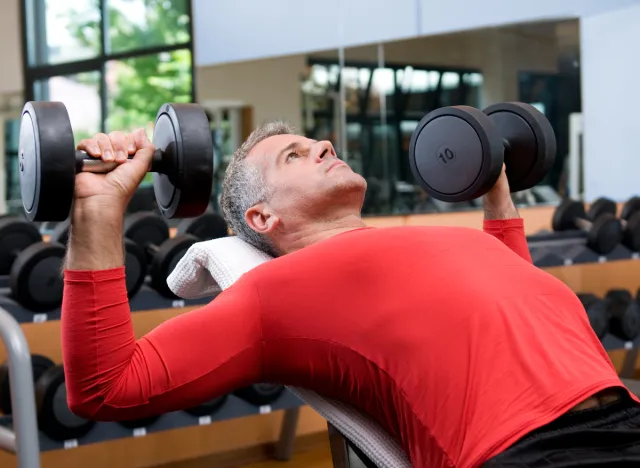Regular exercise is essential if you want to stay healthy, strong, and mobile as you grow into your golden years. However, it’s important to note that not all exercise is created equal. If you want to maximize your longevity, there are certain exercise habits you should avoid at all costs. We’re calling out nine harmful exercise habits for people over 50 and what to do instead, so listen closely.
Making the following mistakes over time means missing out on the multitude of benefits from exercise as a whole when properly programmed. According to research, engaging in physical activity such as resistance training can decrease or even reverse certain natural occurrences that happen with age, such as the loss of bone density and muscle mass, reduced balance, increased risk of falls, and decreased mobility. These are all things you want to delay or avoid for as long as possible so you can continue to lead the independent life you love.
Now, let’s explore nine of the most harmful exercise habits for people over 50 and what to do instead.
You’re not warming up before workouts.

Skipping warm-ups may hit a little too close to home. However, even when you feel like your time is slim, not warming up or cooling down can do your body a major disservice.
“Skipping a proper warm-up increases the risk of muscle strains or injuries—especially as the body’s flexibility and blood circulation decrease with age,” explains Ronny Garcia, CPT, Blink Fitness.
What To Do: The moral of the story? Always perform a solid warm-up before moving into your main workout! “Dedicate time to a dynamic warm-up with light aerobic exercise and dynamic stretches before moving on to more intense activities,” Garcia recommends.
You’re doing too many high-impact activities.


High-impact activities and exercises such as burpees, running on hard surfaces, and jump squats have their place, but beware—they can also put unnecessary and excessive stress on your joints.
What To Do: Garcia suggests opting for low-impact exercises like cycling, swimming, or exercising on the elliptical instead.
You’re overtraining.


Pushing your body to the limit won’t speed up your progress; rather, it can set you back. “Excessive training without the proper rest period can lead to fatigue, increased risk of injury, and even a weakened immune system,” explains Garcia.
What To Do: Garcia stresses the importance of taking rest and recovery days and always being in tune with your body. On R&R days, consider engaging in meditation, light stretching or yoga exercises, and foam rolling. Allow your body to repair itself.
You’re not using the correct form.


“Incorrect form and poor posture during exercise can cause strain on the spine and joints, leading to potential injuries,” Garcia tells us.
What To Do: Make sure to prioritize proper form and technique. When in doubt, it’s always a smart idea to work with a personal trainer to ensure you have your form down pat.
You’re avoiding the weight room.


If you’ve been intimidated by the weight room in the past, you are not alone. Nevertheless, lifting weights is a very important part of any fitness program designed to slow or reverse the aging process.
What To Do: You need to lift challenging weights for a low number of repetitions; they should feel heavy relative to your current strength. For older adults, performing six to 12 reps using a weight that leaves one to two repetitions “in the tank” after the first set is a solid place to start.
You’re skipping mobility work.


Mobility is a vital component of reducing injury and ensuring your joints maintain a normal, functional range of motion. Mobility can include things like yoga, massage, foam rolling, stretching, and any other activities that incorporate some form of stretching or elongation of the muscles.
What To Do: We usually recommend active forms of stretching, such as yoga rather than passive stretching, but both have their benefits. For maximum results, incorporate 30 to 60 minutes of mobility activities three times per week in conjunction with your weight training.
You’re focusing too much on isolation movements.


If you’ve been convinced to lift weights, you still need to use the right movements. It’s easy to become too focused on isolation exercises such as bicep curls, triceps extensions, and leg extensions. While this type of weight exercise has a place in training, the focus should be on compound movements that load multiple muscles and joints.
What To Do: In particular, be sure to include weighted movements like squats or deadlift variations that load the spine vertically. These provide the most benefit regarding bones, muscle, and performance improvements.
You’re only walking on stable surfaces.


Walking is a great addition to weight and mobility training. However, if you only walk on paved surfaces, you miss out on some serious benefits. You may also risk aggravating your joints if the surfaces are always paved.
What To Do: Walking on uneven surfaces such as sand, trails, rocky terrain, and other unpaved surfaces helps improve your balance and ankle strength while reducing the impact on your joints.
You’re skipping exercise altogether.


The absolute worst thing you can do is skip exercise altogether. While the best exercise programs for people 50 and older would follow the above recommendations, doing anything is always better than doing nothing.
What To Do: Short walks, cardio machines, taking the stairs, and other activities are worth shooting for, even if weight training, yoga, and other methods are off the table. Take a walk and do some stretches at the very minimum. Your body will thank you now and later.














Leave a Reply